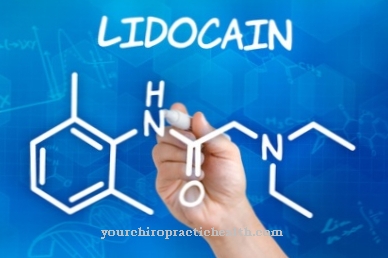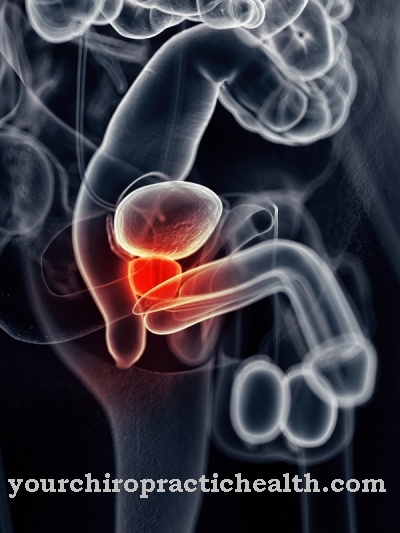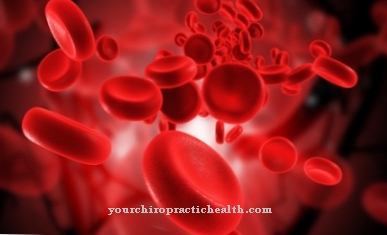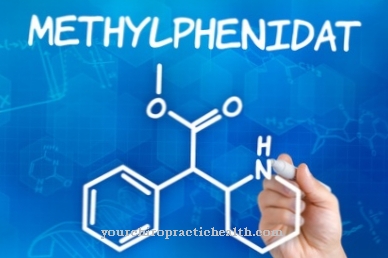Lymecycline is an antibiotic drug from the group of tetracyclines. A synonym for Lymecycline is Lymecyclinum.
What is Lymecycline?

Lymecycline is a semi-synthetic tetracycline derivative. The drug is one of the antibiotics and may only be taken on the prescription of a doctor. Tetracyclines are a group of antibiotic drugs whose original substance was produced from bacteria of the Streptomyces group.
Most tetracyclines and also lymecycline are derivatives of this substance that have been chemically modified. They usually have more favorable pharmacokinetics. This means that they are easier to apply and that absorption and distribution in the body are better. Lymecycline is also better tolerated than the original form of tetracycline.
Lymecycline is available in the form of capsules in specialist pharmacies. The active ingredient is mainly used to treat acne (acne vulgaris).
Pharmacological effect
Lymecycline can inhibit the growth of acne bacteria in the sebum glands of the skin and in the hair follicles. Tetracyclines such as lymecycline have a bacteriostatic effect. This means that although they do not kill the bacteria present, they prevent further growth.
The lymecycline binds to the so-called 30s subunit of the ribosomes in the bacterial cells. Ribosomes are cell organelles that are responsible, among other things, for the translation of RNA. By binding to the 30s subunits, the antibiotic agents modify the addition of the aminoacyl-tRNA. The aminoacyl-tRNA cannot align itself correctly due to the blockade of the subunit at the level of the 50s subunit. Thus, the peptidyl transferase reaction, which is important for reproduction, cannot be carried out properly. The peptidyl transferase catalyzes the peptide bonds between the individual amino acids in the ribosome. It ensures that the amino acids that are supplied by the transport RNAs during translation are linked. When this reaction is inhibited, the peptide chain breaks off during protein synthesis. This inhibits the growth of the bacteria and stops them from multiplying.
In principle, tetracyclines are effective against both gram-positive and gram-negative bacteria. Cell wallless bacterial genera are also sensitive to tetracyclines. Lymecycline works primarily against Propionibacterium acnes.
Medical application & use
Propionibacterium acnes is a gram-positive anaerobic bacterium that is part of the skin flora. The bacterium used to be called Bacillus acnes or Corynebacterium acnes. It is involved in the development of acne. The bacterium mainly lives in the sebum of hair follicles and here in particular in the follicles of the sebum glands.
It has the enzyme lipase and can therefore use components of sebum to generate energy. This allows the bacterium to multiply quickly. However, when the sebum is used, inflammatory substances are produced. Chemotaxis causes the accumulation of white blood cells in the tissue. When the immune cells die, pustules appear that are filled with pus. These pustules are a major symptom of acne vulgaris.
Lymecycline inhibits the reproduction of acne bacteria in the sebum glands and in the hair follicles. This prevents the formation of pustules, cysts and inflammatory pus vesicles.
Risks & side effects
The drug lymecycline requires a prescription. It must not be prescribed in the case of a known hypersensitivity to tetracycline. The active ingredient can bind to calcium in the body and thereby store it in the bone and tooth-forming tissue. This can lead to temporary growth disturbances, which can also lead to malformation of the tooth enamel. Furthermore, unsightly tooth discoloration can occur. Tetracyclines such as lymecycline must therefore not be used in children under eight years of age and in pregnant women. Lymecycline must also not be taken during breastfeeding.
The drug must not be taken at the same time as oral retinoids. Among the retinoids are some medicines that are also used to treat acne.
Long sunbathing should be avoided while taking Lymecycline. Skin reddening can occur when exposed to direct sunlight or UV radiation. In addition, the effects of blood-thinning medication (anticoagulants) can be increased by taking lymecycline, so that bleeding can occur.
Patients taking antacids for stomach upset should not take these acid-binding drugs with lymecycline. The antacids affect the absorption of lymecycline into the blood.
Headache, upper abdominal pain, and nausea may occur when taking Lymecycline. Occasionally, that is, about 1 in 100 people will develop a rash. Seizures, fatigue, vomiting, diarrhea, sore throat, dermatitis and muscle pain are also some of the occasional side effects.
In rarer cases, serious, generalized allergy reactions can appear. The face, including the eyes and lips, can swell. The swelling may spread to the tongue and throat. Life-threatening attacks of suffocation can result. Furthermore, taking Lymecycline can lead to increased intracranial pressure, inflammation of the intestines, inflammation of the tongue, visual disturbances and fever.
If skin rashes or allergic symptoms occur, treatment with lymecycline must be stopped immediately. The attending physician should be informed as soon as possible in the event of any other side effects.



























